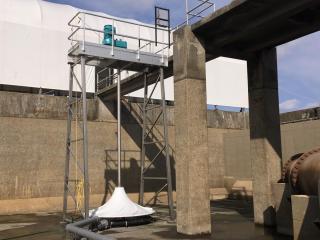Phase A Press Release

Upper Blackstone Clean Water Engineer Director / Treasurer Karla Sangrey announced today that Upper Blackstone’s Phase A Nutrient Removal Project has been completed. The Phase A Project is the first part of a multi-phased plan to reduce the total effluent nitrogen and phosphorus as mandated by an administrative order on consent (AOC) between Upper Blackstone and the United States Environmental Protection Agency, which will bring Upper Blackstone into compliance with the terms of their National Pollutant Discharge Elimination System (NPDES) Permit. The construction was completed by the date mandated in the AOC and under the $23M project budget. It was funded in part by the Clean Water State Revolving Fund through the Massachusetts Department of Environmental Protection.
Upper Blackstone Clean Water is a public agency that provides wastewater treatment services to its member communities of Auburn, Cherry Valley Sewer District, Holden, Millbury, Rutland, West Boylston, and Worcester as well as regional sludge and septage treatment.
The Phase A project had many components including automating the biological nutrient removal system, upgrading the regenerative thermal oxidizers (RTO) air pollution control system, and installing new chemical feed systems. One of the highlights of this project is the Magnesium Hydroxide Facility, which houses one of the new chemical feed and storage systems. Magnesium hydroxide is used for pH adjustment and alkalinity control in the biological nutrient removal process. The building was constructed with state-of-the-art green infrastructure including:
- A vegetated roof to provide stormwater management by reducing the flow directed to the stormwater system, improved insulation with the additional layers of soil and vegetation, extending the roof life by protecting the membrane roof from the sun’s UV rays, and reducing greenhouse gas emissions with the plants converting carbon dioxide to oxygen as they grow.
- A water-to-water heat pump utilizing plant effluent, which typically averages about 60°F throughout the year, to supplement the heating and cooling systems.
- A solar wall to reduce the heating load. Outside air is preheated by the sun before entering the air handling unit, reducing energy consumption in the winter months.
- Passive natural lighting is provided by windows on the east and north sides of the building throughout the day. Windows on the west and south side of the building were reduced, which limits the direct sunlight to the facility during the warmer months thereby reducing cooling needs.
- Porous pavers installed around the facility allow rainwater to infiltrate into the ground, reducing flow directed to the stormwater collection system.
The green infrastructure design concepts that were used on this building help to decrease the environmental impact and operating costs for the new facility, as well as provide a “pilot study” to determine whether they can be used elsewhere at Upper Blackstone. For more information on Upper Blackstone see ubcleanwater.org.

